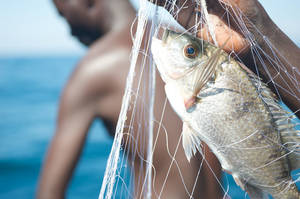More people than ever before rely on fisheries and
aquaculture for food and as a source of income, but harmful practices and
poor management threaten the sector’s sustainability, says a new FAO
report published today.
According to the latest edition of FAO’s The State of World Fisheries and
Aquaculture, global fisheries and aquaculture production totalled 158
million tonnes in 2012 - around 10 million tonnes more than 2010.
The rapid expansion of aquaculture, including the activities of small-scale
farmers, is driving this growth in production.
Fish farming holds tremendous promise in responding to surging demand
for food which is taking place due to global population growth, the report
says.
At the same time, the planet's oceans – if sustainably managed – have an
important role to play in providing jobs and feeding the world, according
to FAO's report.
“The health of our planet as well as our own health and future food
security all hinge on how we treat the blue world,” FAO Director-General
José Graziano da Silva said. “We need to ensure that environmental well-
being is compatible with human well-being in order to make long-term
sustainable prosperity a reality for all. For this reason, FAO is committed
to promoting 'Blue Growth,' which is based on the sustainable and
responsible management of our aquatic resources.”
The renewed focus on the so-called “blue world” comes as the share of
fisheries production used by humans for food has increased from about 70
percent in the 1980s to a record high of more than 85 percent (136 million
tonnes) in 2012.
At the same time per capita fish consumption has soared from 10 kg in the
1960s to more than 19 kg in 2012.
The new report also says fish now accounts for almost 17 percent of the
global population’s intake of protein -- in some coastal and island
countries it can top 70 percent.
FAO estimates that fisheries and aquaculture support the livelihoods of
10–12 percent of the world’s population.
Since 1990 employment in the sector has grown at a faster rate than the
world’s population and in 2012 provided jobs for some 60 million people
engaged in capture fisheries and aquaculture. Of these, 84 percent were
employed in Asia, followed by Africa with about 10 percent.
FAO








No comments:
Post a Comment